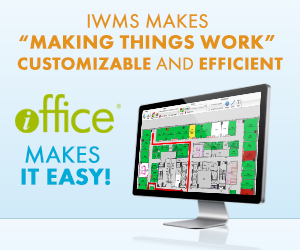Facility managers are often tasked with the somewhat thankless job of making the resources available to them work, sometimes on a grand scale. Due to advancements in technology and enterprise level resources, however, the tools and resources available to assist this job are better than ever. The acronym IWMS stands for “Integrated Workplace Management System” and refers to a type of software that can help professional facility managers better manage their resources. They will no longer just be “making things work” – they’ll be making them work efficiently and in a much more cost effective manner than ever before.
One of the major benefits of an IWMS is that it is inherently customizable to meet the needs of your  organization. Even if two completely different companies are using the same deployment, they likely are doing so in substantially different ways. No two organizations are created quite the same, which is why there should not be a “one size fits all” solution to facility management. Along the same lines, facility management is capable of growing and evolving, just as your organization does. The larger your company, the more helpful you’ll find an integrated workplace management system on a daily basis.
organization. Even if two completely different companies are using the same deployment, they likely are doing so in substantially different ways. No two organizations are created quite the same, which is why there should not be a “one size fits all” solution to facility management. Along the same lines, facility management is capable of growing and evolving, just as your organization does. The larger your company, the more helpful you’ll find an integrated workplace management system on a daily basis.
One of the major ways in which a facilities management software, can help leaders be successful is through a much more efficient use of their existing space. The IWMS will allow you to see all data, related to the space you have available to you, in a real-time environment that is constantly updating. As a result, you’ll be able to see which physical spaces are operating at peak efficiency and which could use a little rearranging to help increase productivity. Even if it boils down to just rearranging where a specific department is located or changing where certain employees are sitting, you can accomplish all of that and more with an IWMS deployment.
Another important way in which an integrated workplace management system can help make things work has to do with budget preparation. When utilized properly, these types of facility management systems can present a detailed analysis of cost data in association with each department that you’re in charge of. Simply put, you’ll not only see where every last cent is going but you’ll be able to use trend analysis, projection data and more to help see where money is being used efficiently and where it is essentially being wasted.
Armed with this information, you’ll have the ability to better prepare a budget in the future and will also have the tools that you’ll need to justify one or more line items should the need arise. You’ll have complete control over the budget of your facility, including reporting capabilities, on any device with an Internet connection like a smartphone, tablet or laptop computer.
One other area in which an integrated workplace management system excels has to do with work order management and ongoing scheduled tasks. These types of software solutions facilitate the receipt, dispatch and tracking of work orders related to on-demand or preventative maintenance requests. You can update and maintain real-time statistics on activity, time, supplies used and performance. You’ll be just a few quick mouse clicks (or finger taps, in the case of a smartphone) away from seeing which requests are on time and which ones are in danger of falling behind. You’ll also be able to use the same dashboard interface to identify certain threats that may be looming, with regards to request completion, as well as communicate with independent contractors, staff members, clients and other valuable contacts.
Facilities management can be a difficult and time-consuming profession, if you are not prepared for how to manage your time, people and resources. Luckily, the information age has given us powerful and creative solutions to ensure the jobs are done to the highest standards, with the greatest efficiency. It is in your best interest to explore your options and choose a management system to best help you in your endeavors.
[blog_cta id=’767fed61-de1f-4c16-9084-08ef7b96ba8f’]
